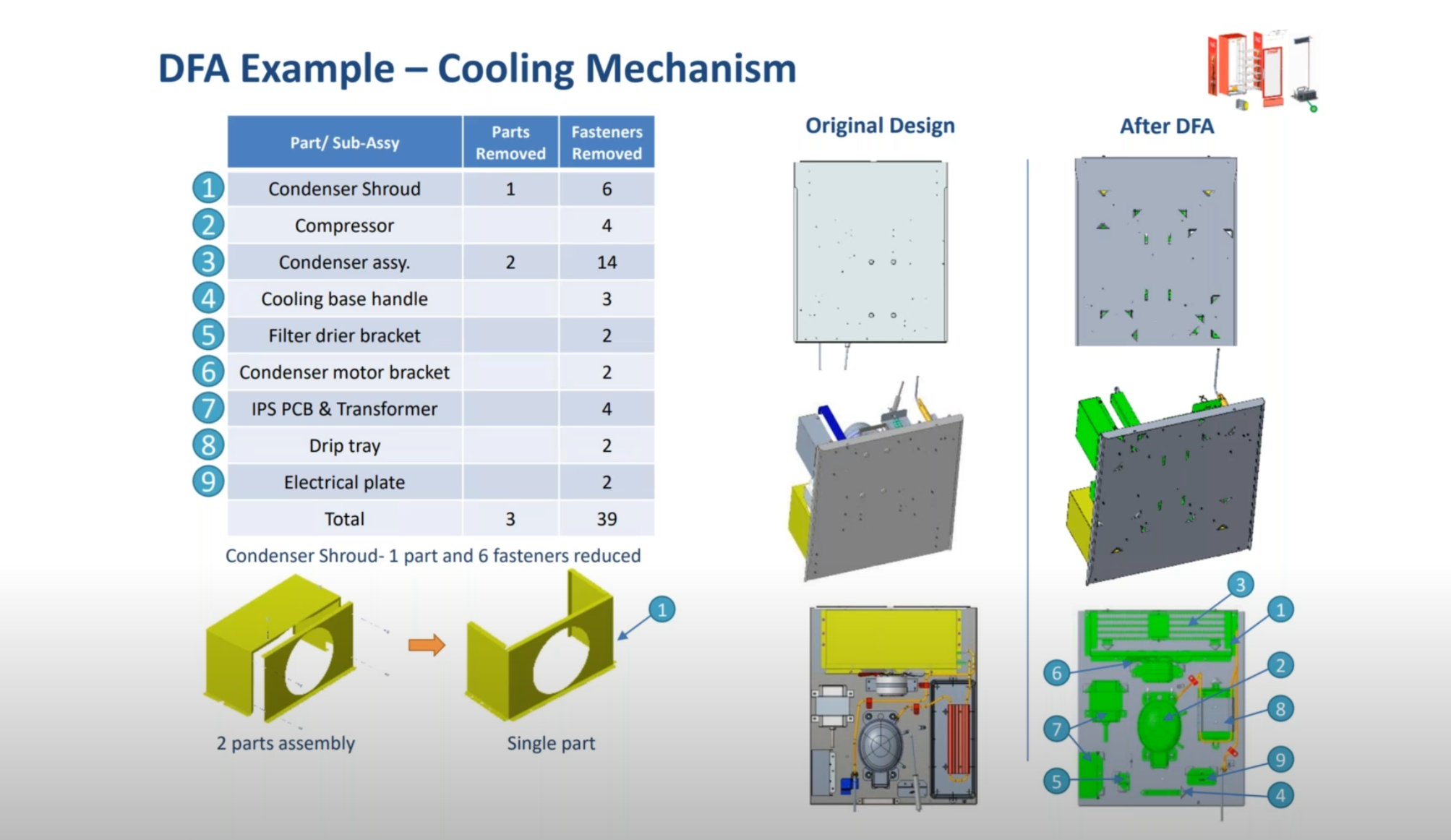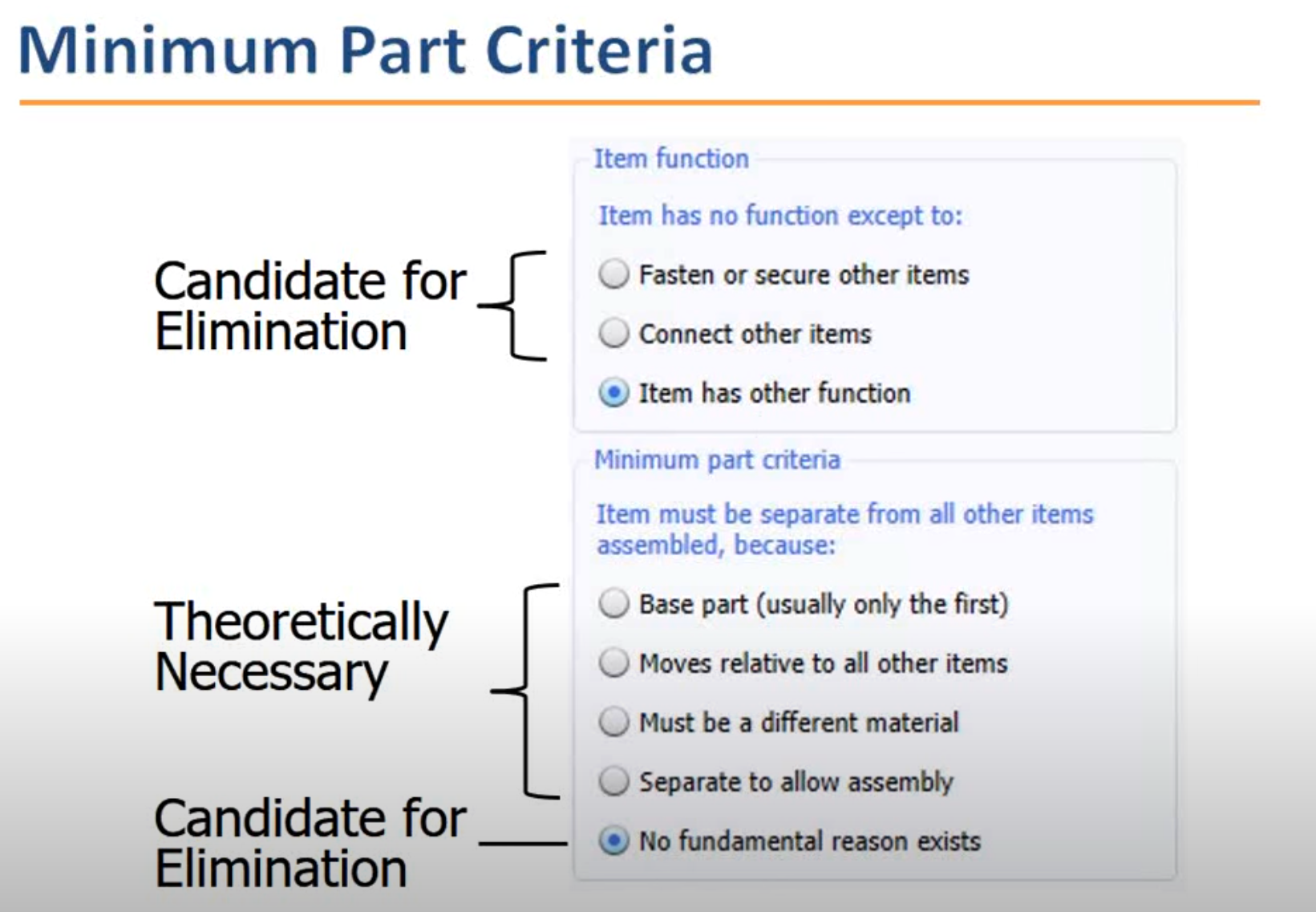
Benefits: Significantly Reduce Product Cost and Improve Reliability
Strategy: Design the Product to Be Easy to Assemble
Design for Assembly (DFA) is a product development strategy that can substantially reduce total product cost and improve reliability without compromising a product’s functionality. This approach focuses on simplifying the product structure to make assembly easier, faster, and more cost-effective. Unlike traditional cost reduction strategies that primarily target individual part costs, DFA emphasizes the overall assembly process, leading to more significant and sustainable cost savings.
Since the 1980s, hundreds of companies have achieved an average product cost savings of 50% through Product Simplification—a core principle of DFA. This methodology has been successfully applied across various industries, including automobiles, electronics, consumer goods, medical devices, industrial equipment, and aerospace, demonstrating its versatility and effectiveness in enhancing product competitiveness.
Why Should I Care About Assembly Labor?
A common product cost reduction strategy involves designing individual parts to be simpler, easier to manufacture, and less expensive to produce. Engineers often focus intensely on minimizing part costs, believing that reducing the cost of each component will lead to overall product savings. However, this approach can be misleading.

The reality is that focusing solely on part costs can inadvertently lead to a higher total product cost compared to strategies that emphasize minimizing assembly labor. This counterintuitive outcome arises because designing parts to be easy to manufacture often results in an increased total number of parts. Conversely, designing a product to be easy to assemble typically reduces the number of parts required.
Industry research has demonstrated that, thanks to modern manufacturing techniques, using fewer parts is frequently less expensive than utilizing a large number of inexpensive parts. Additionally, a reduced part count offers several advantages:
- Ease of Service: Fewer parts simplify maintenance and repairs, reducing service time and costs.
- Reduced Defects: With fewer components, the likelihood of defects decreases, enhancing overall product quality.
- Increased Reliability: Simplified assemblies are generally more reliable over the product's lifetime.
Ultimately, Product Simplification ensures that more value is captured by both the manufacturer and the consumer, fostering a win-win scenario where products are both affordable and dependable.
How Do I Execute This Strategy?
In theory, designing a product with fewer parts and simpler assemblies seems straightforward. However, in practice, many finished designs remain inefficient because the product development team either lacks sufficient time or does not recognize which parts should be combined. To effectively execute the DFA strategy, the following steps are essential:
1. Early Integration of DFA Software
The early use of Design for Manufacture and Assembly (DFMA) software is critical. DFA Product Simplification software quantifies assembly efficiency and provides actionable suggestions for redesigning products to enhance performance and reduce part counts. By analyzing the current design, DFA tools can identify opportunities for part consolidation and simplification.
2. Assembly Efficiency Quantification
DFA software evaluates the assembly process, identifying bottlenecks and inefficiencies. It measures factors such as the number of assembly steps, the time required for each step, and the potential for automation. This quantitative analysis helps in making informed decisions about which aspects of the design can be improved to streamline assembly.
3. Redesign Suggestions
Based on the analysis, DFA tools offer redesign suggestions that aim to reduce the number of parts and simplify the assembly process. These suggestions often lead to improvements in product performance, as simpler designs are typically more robust and easier to use.
4. Calculating the Theoretical Minimum Number of Parts
DFA software calculates the theoretical minimum number of parts required for the product. This calculation provides a benchmark for designers, highlighting the maximum potential for part consolidation. Understanding the minimum part count helps teams set realistic goals for design simplification.
5. Cost Comparison with DFM Software
Once DFA redesigns are proposed, the should-cost of each iteration can be quickly compared using Design for Manufacture (DFM) software components. By integrating DFA and DFM tools, development teams can assess the cost implications of design changes in real-time, ensuring that cost reduction goals are met without sacrificing quality or functionality.
6. Iterative Design Refinement
Design teams should engage in an iterative process, continuously refining the product design based on feedback from DFA and DFM analyses. This iterative approach ensures that the final product design is optimized for both assembly efficiency and manufacturing cost-effectiveness.
Implementing Design for Assembly in Your Organization
1. Foster a Collaborative Culture
Encourage collaboration and open communication between design, manufacturing, and assembly teams. Promoting mutual respect and understanding of each team's expertise ensures that assembly considerations are integrated into the design process from the outset.
2. Invest in Training and Tools
Provide training to team members on DFA principles, methodologies, and software tools. Investing in advanced DFMA software equips teams with the resources they need to effectively simplify product designs and optimize assembly processes.
3. Establish Clear Processes and Standards
Develop and implement clear processes and standards for DFA. Define roles and responsibilities, establish standardized procedures for design and assembly collaboration, and set clear expectations for part consolidation and assembly efficiency.
4. Utilize Cross-Functional Teams
Create cross-functional teams that include members from design, manufacturing, engineering, and assembly departments. These teams facilitate the exchange of diverse perspectives and expertise, leading to more comprehensive and optimized product designs.
5. Continuously Monitor and Improve
Regularly review and assess the effectiveness of the DFA process. Gather feedback from team members, analyze performance metrics, and identify areas for improvement. Embrace a mindset of continuous improvement, seeking out innovative solutions and best practices that can enhance the DFA strategy and drive ongoing cost reductions and efficiency gains.
Conclusion
Design for Assembly is a transformative strategy for companies aiming to develop cost-effective, reliable, and high-quality products. By focusing on simplifying product designs and optimizing the assembly process, organizations can achieve significant cost savings, enhance product reliability, and improve overall competitiveness in the market.
Implementing DFA requires a commitment to collaboration, continuous improvement, and strategic decision-making. However, the substantial benefits—ranging from reduced manufacturing costs and improved reliability to increased customer satisfaction—make it an invaluable approach for any forward-thinking organization.
Embracing Design for Assembly not only streamlines the production process but also positions companies to better meet market demands, respond to customer needs, and achieve long-term success in an ever-evolving business landscape.
Ready to optimize your manufacturing process with Design for Assembly? Contact Us Today to get started!





 Unlocking the Power of Design for Assembly
Unlocking the Power of Design for Assembly


